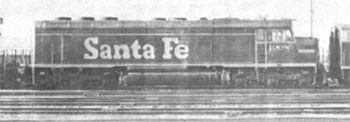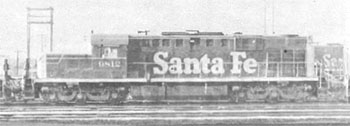(continued from preceding page)
The rear radiators at the top of the long hood flare out, giving the SD45 a distinquishing trademark not duplicated on any other EMD standard single-engine model.
Like the SD40s, the SD45 first went into production in 1965, and began appearing on Southwast lines in in 1966.

EMD / F45 / 3600 hp / 6 axles C-C wheel arrangement SANTA FE 5900-5939 (1900-1939).
The F45s owe their ancestory to EMD FP45s which were built on special order for Santa Fe to handle passenger service and were delivered in passenger colors. Apparently Santa Fe liked the new style body (the FP45 is basicly an SD45 with a cowled car body and steam generator), for instead of reordering SD45s the road asked for a freight version of the FP45.
The units are vary distinctive in appearance, harking back to the early days of dieselization and the old cab E- and F- units.
Evidently the reasoning behind the new style body claims better protection against dust and dirt for the diesel engine.
Only two other roads have thus far followed Santa Fe with the new body style, but the new UP Centinneal twin-engined locomotives have similar styling. Whether or not this will become the standard style for diesel electrics in the future remains to be seen.

ALCo / RSD 15 (DL-600B) / 2400 / 6 axles C-C wheel arrangement SANTA FE 9800-9849 (800-849) / SP 5160-5162.
These arresting locomotives, built by the now out of business American Locomotive Company between 1956 and 1960, are quite rare. The Santa Fe roster is the largest in the country.
This model is very easy to recognize by its typical ALCo notches cut into the corners of both hoods. The DL-600B has a long short hood that further distinquishes it from similar ALCo models.
The ALCo demonstrators for this model, which were similar in appearance with the exception of a high short hood, were purchased by Santa Fe in 1955. Numbered 601 and 602 (with a completed roster of 607-611 for these DL-600s), these one-of-a-kind class are in all probability gone now.
The never DL-600Bs came to Santa Fe in 1959 and are still very active. They're often seen in San Diego.
+++++++++++++++++++++++++++++++++++++++++++++++++++++++++++++++++++++++++++++++++++++++++++++++++
When steam ruled American rails very few railfans considered the possibility that the iron horse as they knew it would disappear. But in a brief ten years the steam locomotive disappeared from mainline railroads, and within a short time after that was gone from even the smallest of the branch lines.
Today, second-generation diesels are becoming more frequent. The FTs that ushered in the age of dieselization are virtually gone, and the GP7s and 9s that introduced American railroads to nation-wide standardization are beginning to disappear.
The ALCo PA has virtually disappeared, and one must travel eastward to the minor Delaware & Hudson in order to observe the few ex-Santa Fe units working there. How long these will last is anyone's guess, but they are now over twenty years old.
For that matter, ALCo itself is gone. And so it the locomotive erectors of Baldwin, Fairbanks-Morse, Lima-Hamilton and a flock of other minor manufacturers that made their contributions to the demise of steam before expiring themselves.
Many of these historical...yes, classic locomotives are still in existence. But how long they will last is anybody's guess. If, on your travels, you have an opportunity to do a little train watching, do not pass it up.
And don't forget your camera. A few years from now you may go through your files and comment "There's a GP7...you know, I haven't seen any of those recently. I wonder what happened to them all...."